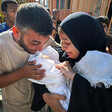Rights and Accountability 30 May 2024

Displaced Palestinians dismantle their tent to flee to safer areas after Israel attacked an encampment near UNRWA’s warehouses in Rafah, southern Gaza, 27 May.
APA imagesScores of civilians have been killed in Rafah, southern Gaza, and elsewhere in the coastal enclave since Friday, when the International Court of Justice ordered Israel to immediately halt its offensive in Rafah.
Instead of heeding that order, Israel is “intensifying its ground incursion, accelerating the pace of aerial and artillery bombardment and expanding its circle of killing and direct targeting of civilians,” the Euro-Med Human Rights Monitor said on Tuesday.
More than 12 Palestinians were killed in an early morning Israeli airstrike in Rafah, southern Gaza, on Thursday as they reportedly attempted to recover the body of a civilian.
Israel seized control of the corridor along Gaza’s southern boundary with Egypt, the military said on Wednesday, as the humanitarian situation in the territory worsened with the ongoing closure of Rafah crossing.
Israel now has “effective authority over the Palestinian territory’s entire land border,” Reuters reported.
Israel had taken control of the now shuttered Rafah crossing between Gaza and Egypt on 6 May, preventing medical evacuations from the territory and throttling the transfer of humanitarian aid.
Reuters reported on Thursday the Israeli military had “lifted a ban on the sale of food to Gaza from Israel and the occupied West Bank,” citing Palestinian officials, businessmen and international aid workers.
“Aid workers have urged Israel for months to allow more commercial deliveries to enter Gaza so fresh food can supplement international aid, which mostly contains non-perishables like flour and tinned food,” Reuters stated.
But the entry of deliveries via Kerem Shalom, Gaza’s commercial crossing, has been erratic and only 20 to 150 trucks per day are being allowed in by Israel, according to Palestinian officials – far short of the 600 trucks per day that the US State Department says is needed to avert famine.
Reuters said that food brought into Gaza by merchants is being unevenly distributed and sold at prices that are out of reach for most people in the territory, who have been repeatedly displaced and are cash-strapped after nearly eight months of war that has brought the economy to a standstill.
Aid workers told Reuters that the commercial shipments of food, bearing Hebrew-language labels, are “scant replacement for international aid that has already been paid for by donor countries and organizations.”
Flight from Rafah
On Friday last week, the International Court of Justice ordered Israel to reopen the crossing and halt its offensive in Rafah “which may inflict on the Palestinian group in Gaza conditions of life that could bring about its physical destruction in whole or in part.”
Most of Gaza’s population of 2.3 million Palestinians had sought refuge in Rafah after being forcibly transferred from other areas of the territory.
More than a million people had fled the area over the past few weeks, according to UNRWA, the UN agency for Palestine refugees.
Until Israel’s ground offensive in the area began a few weeks ago, Rafah had served as the hub for humanitarian operations in Gaza for the past several months.
The UN Office for the Coordination of Humanitarian Affairs said on Wednesday that the flow of humanitarian aid into Gaza, “already insufficient to meet the soaring needs, has dropped by 67 percent since 7 May.”
A floating pier built by the US military off of Gaza’s coast at a cost of $320 million has been temporarily removed after a part of it broke off in inclement weather after only a week of being operational.
Humanitarian facilities in Rafah have been forced to shut down “one after another,” the UN added, with only one hospital in the area remaining partly functional.
Hospitals and health facilities in other areas of Gaza aren’t faring much better. The World Health Organization warned that the few hospitals that are still able to provide care are quickly running out of vital supplies.
“There are 60 WHO trucks standing in El Arish [in Egypt] ready to get into Gaza,” said Rik Peeperkorn, the UN health organization’s representative in Palestine.
“The Rafah crossing needs to be opened not just for medical supplies, but for all other humanitarian supplies,” he added.
Stores of aid were set on fire by Israeli air strikes, Reuters reported on Wednesday.
The Palestine Red Crescent Society said that it was forced to evacuate its medical teams from a field hospital in al-Mawasi, in western Rafah, due to repeated bombing in what Israel had declared to be a “humanitarian zone.”
The humanitarian group added that two of its staff were killed when the ambulance in which they were traveling was hit while on a rescue mission in Rafah.
Footage shows Red Crescent workers recovering the charred remains of their colleagues from the blown-apart ambulance.
The US-based charity Save the Children said on Wednesday that 66 Palestinians had been killed and hundreds more injured over “four deadly days” in Rafah.
Twenty-one Palestinians, more than half of them women, were reported killed in an Israeli attack in al-Mawasi on Tuesday.
On Sunday, at least 46 Palestinians were killed in an Israeli airstrike on a camp for displaced persons in the Tal al-Sultan area of Rafah, where UNRWA is currently headquartered and has warehouses.
More than 50 independent UN human rights experts condemned the massacre in Tal al-Sultan and demanded accountability, including immediate sanctions.
“The flow of arms into Israel must stop immediately,” the experts said.
US munitions used in Rafah massacre
Separate visual analyses undertaken by The New York Times and CNN both concluded that US weapons were used by Israel in the Tal al-Sultan attack.
Horrific images of the aftermath showing screaming survivors pulling charred bodies from the fire and a decapitated child fueled global condemnation, including from top UN officials.
“Munition debris filmed at the strike location the next day was remnants from a GBU-39, a bomb designed and manufactured in the United States,” The New York Times reported.
The Biden administration has encouraged Israel to use these types of more precise bombs rather than 2,000-pound bunker buster bombs that have caused extensive destruction in Gaza. Biden announced earlier this month that Washington had paused delivery of those heavier weapons to Israel.
Footage of the weapon fragments shows a serial number tracing the bomb to Woodward, a manufacturer in Colorado that supplies parts to the US military, according to the Times.
CNN said that it reviewed video which it had geolocated to the scene of the massacre showing remnants of the Boeing-manufactured GBU-39 bearing serial numbers tracing back to a manufacturer in California.
Israel claims that it targeted two Hamas commanders in Sunday’s strike and its military has suggested that the fire that engulfed the encampment may have been caused by a secondary explosion.
Two former US military officials told The New York Times that the use of precise weapons in densely populated areas like the Rafah camp would predictably result in civilian casualties.
White House national security spokesperson John Kirby, who has reflexively defended Israel’s actions throughout the nearly eight months of carnage in Gaza, said that the reported use of the smaller weapons “is certainly indicative of an effort to be discreet and targeted and precise.”
Antony Blinken, the US secretary of state, was slightly less conciliatory, calling Sunday’s attack “horrific” and said that he was awaiting the results of an Israeli investigation into the incident.
Last week, Karim Khan, the chief prosecutor of the International Criminal Court, alluded to Israel’s self-investigations mechanisms as being a “sham” to evade accountability in his announcement that he was seeking arrest warrants for two Israeli officials and three Hamas leaders.
The use of US weapons in apparent war crimes such as Sunday’s massacre in Rafah implicates officials in Washington, who have provided not only arms but also diplomatic cover prolonging Israel’s campaign in Gaza that has killed more than 36,000 Palestinians since 7 October.
The actual fatality count is likely much higher, with thousands of people missing under the rubble. An unknown number of Palestinians in Gaza have died in a secondary wave of mortality as Israel has destroyed water and sanitation facilities in the territory, giving rise to diseases, all while engineering a famine and destroying the healthcare system.
Biden says no change in policy
After saying for months that a major operation in Rafah was a red line, the Biden administration said there would be no change in policy towards Israel even after the massacre on Sunday and as tanks advanced further into the area.
“How many more charred corpses does he have to see before the president considers a change in policy?” Ed O’Keefe, a senior correspondent for CBS, asked Kirby during a press briefing on Tuesday.
“I kind of take a little offense at the question,” Kirby responded. “No civilian casualties is the right number of civilian casualties.”During a press conference on Wednesday, Blinken signaled frustration over what he said was Israel’s lack of post-war plan in Gaza. The secretary of state said that “in the absence of a plan for the day after there won’t be a day after,” leaving Hamas “in charge.”
Israeli Prime Minister Benjamin Netanyahu appears to be in no hurry to end the fighting in Gaza. Tzachi Hanegbi, his national security adviser, told Israeli public radio on Wednesday that the war was expected to last through the end of the year or longer.
Hamas says that it will not release any captives held in Gaza without an end to the war and withdrawal of the Israeli military from the territory.
Three Israeli soldiers were killed and three more badly injured by an explosive device in a booby-trapped building in Rafah, the military admitted on Wednesday.





